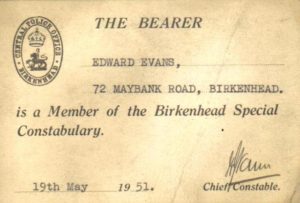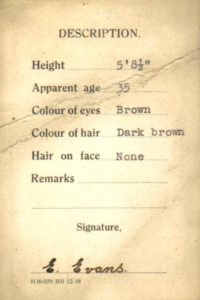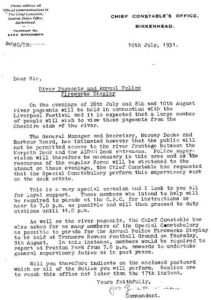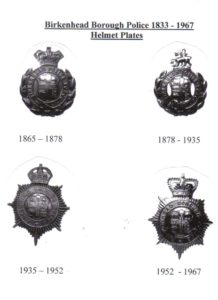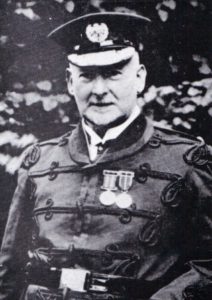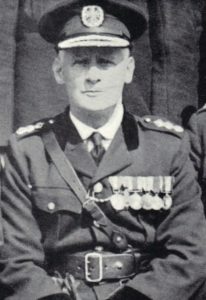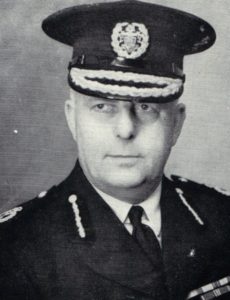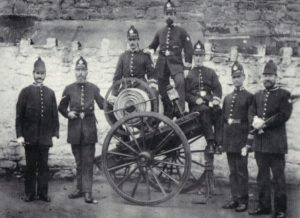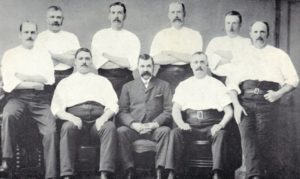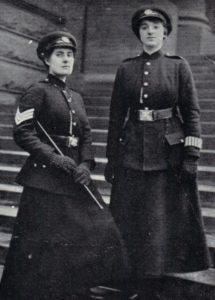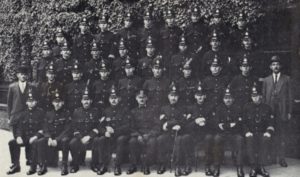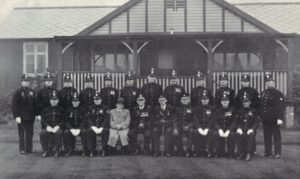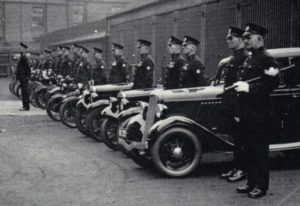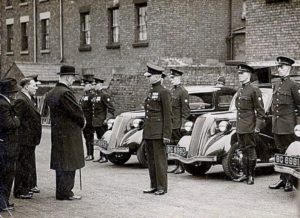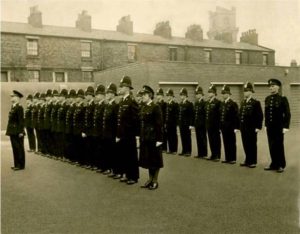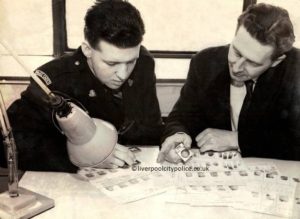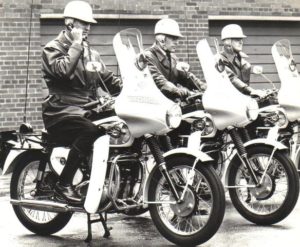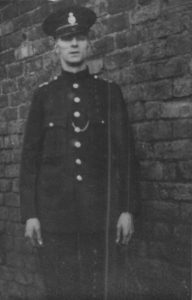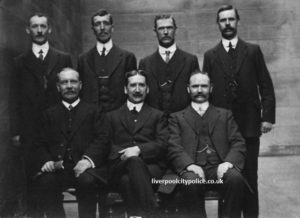BIRKENHEAD BOROUGH POLICE by brian starkey, retired
Birkenhead Borough Police Force was formed in 1836 and was the largest borough police force in the country. It numbered around 400 officers in its heyday due to an arrangement with the Mersey Docks and Harbour Board to police the Birkenhead and Wallasey docks.
Birkenhead Borough Police Force was amalgamated with Cheshire Constabulary on 1st July 1967 and became a division of Merseyside Police on 1st April 1974.
ITS HISTORY
In 1837 the strength of the Birkenhead Police consisted of 3 night watchmen and one parish constable. At that time they did not have a Head Constable and the ‘Captain of the Night Watch’ was Captain Gleave.
Captain Gleave was succeeded as ‘Captain of the Night Watch’ by Superintendent Boughey in 1839. The Force’s strength had increased to 5 night watchmen, 2 day constables and one parish constable.
In 1841 Superintendent Porter was appointed as ‘Captain of the Day Watch’. Boughey remained as ‘Captain of the Night Watch’. About this time the weekly pay of the members of the Force was 18s.0d (90 pence).
The year 1843 saw the first mention of a combined Police and Fire Force under the command of Superintendent McHarg. Dr. Jenette was also appointed as the first Police Surgeon at a salary of £10 per year.
In 1845 the Force establishment increased to 30 and in 1847 increased to 52. However, in 1848 it was reduced to 36 due to financial difficulties. Superintendent McHarg retired in 1855 and command was transferred to Inspector Birnie who was immediately promoted to Superintendent. That year presented the introduction of 3 days annual leave with pay “to those members of the Force who shall have conducted themselves to the satisfaction of the Watch Committee for 12 months”.
During 1857 the first ‘Record of Statistics’ was written and the returns of crimes in the Borough was submitted to the Watch Committee.
In March 1858 the rank of Sergeant was created and first class officers (10 in number) wore stripes on the arm. That same year the Mersey Docks and Harbour Act came into force and as a result the Force was obliged to provide constables for policing the docks at the expense of the Dock Board. At this time 3 constables were detailed for this duty. Finances had improved and a new ‘lock-up’, containing two cells, was built at the junction of Cleveland Street and Bridge Street at a cost of £243. Uniforms changed, tunics replacing frock coats and helmets being adopted. By 1859 the strength of the Force had increased to 54 and 12 constables deployed on the docks at an annual cost of £249 18s. 3d. billed to the Mersey Docks and Harbour Board.
In 1862 the Mounted Department was born consisting of 6 constables.
In 1863 Major Beswicke was appointed as the first Head Constable and Superintendent Birnie became his deputy. The Force strength increased to 75.
The introduction of the ‘Merit Badge was established in 1867, for exceptional zeal, gallantry and daring. If awarded the holder received 3d. per day extra pay and wore a small silver badge on the right arm. Constable 65 Moore was the first officer to be granted the badge “for his activity and exertion in arresting a gang of burglars”.
In October 1867 the Force was issued with firearms. The Head Constable reported that he had received from Chester Castle, 30 pistols, pouches and holsters, together with ammunition, for police purposes. No record is shown of these being issued to police and it is presumed that they were placed in store in case of emergency.
In 1869 Major Beswicke resigned as Head Constable and for a few months Superintendent Birnie acted in that capacity until the appointment of Head Constable Kinchant.
In 1871 the establishment of the Force was 85 consisting of:
One Head Constable; one Superintendent; nine Inspectors; two Detective Officers; three Clerks and Bridewell Keepers, and 69 Constables.
In December 1875, Head Constable Kinchant resigned his position as Head Constable because he had been appointed Chief Constable of Warwick. He was succeeded on 13/02/1876 by Major J. B. Barker. Barker was a strict disciplinarian and fined constables a day’s pay for each time they were late for duty. There was also a marked decrease in the number of constables being drunk on duty.
In 1878 the Force establishment increased to 136 and was divided as follows:
“A” or Town Division – 6 Inspectors, 44 Constables
“B” or Claughton Division – 3 Inspectors, 21 Constables
“C” or Tranmere Division – 3 Inspectors, 22 Constables
“D” or Docks Division – 3 Inspectors, 24 Constables
The first “Black Maria” was mentioned in 1879, when tenders were invited for “a prisoners conveyance van” divided into two compartments and capable of holding 6 persons, with a driver’s box for two constables and a conductor’s covered seat behind, to be drawn by one or two horses. That same year it would appear that all police stations were connected by telegraph. Officers performing duty in plain clothes were given an allowance of 3s. 0d (15p) per week.
In January, 1882 the rank of Head Constable was replaced by Chief Constable.
In 1887 all police stations were connected by telephone.
In January, 1891 Inspectors and Constables received an increase of pay of 1s. 0d (5p) per week to bring them nearer the rate paid to constables in Liverpool.
In 1895 the Fire Brigade was made independent of the Police with the opening of the Central Fire Station at Charing Cross.
Chief Constable Barker resigned in 1898 and was succeeded by, Chief Constable, Walter S. Davies. In February, 1899 the first promotion exams were introduced to the rank of Sergeant. Each constable had to pass a simple examination in Dictation, simple arithmetic, making a short official report, and police duties. The pass mark was 33% and the papers marked by an independent person.
The first form of transport for use by members of the Force was introduced in July, 1899 with the purchase of a bicycle for use by members of the CID. Later that year a further bicycle was purchased for the use of superior ranks.
1900 was a notable year in the history of Birkenhead so far as crime is concerned, for in that year the murder known as “The Post Office Murder” was committed. The crime occurred on 9th. September when George Fell, a watchman at the General Post Office, Conway Street, was brutally murdered. The murderer escaped with a considerable amount of money, leaving no clues as to his identity.
By the end of 1901 the strength of the Force was 191. The district of Tranmere was growing rapidly and by the end of 1904 the Force establishment was 198. In 1905 the Chief Constable reported that crime had increased dramatically in the Borough and laid blame on “the large criminal population in Liverpool who had the facility of access to this Borough”. As a result a further 15 constables were appointed.
The first signs of discontent within the Force appeared in January 1909, when the Chief Constable reported that a number of members of the Force were joining political clubs in the town. He pointed out that it was a condition of service that members of the Force should not join such organisations. It was resolved that in the future this condition would be strictly enforced.
In 1912, Chief Constable Davies resigned due to illness and Superintendent Parker took over as Acting Chief Constable.
On 10th March, 1913 Superintendent Edward Parker was appointed Chief Constable and his place as Superintendent was filled by Inspector Charles Jones. Parker was the first Chief Constable who had risen through the ranks of the Force to the most senior position. At the close of 1913 the strength of the Force stood at 238, consisting of one Chief Constable, one Superintendent, six Inspectors, 18 Sergeants and 212 Constables.
In October, 1918 a Sergeant Ingham presented a petition to the Watch Committee requesting an increase in pay, which was granted. The Sergeant informed the committee that he was a member of the National Union of Police and Prison Officers (NUPPO), and that he was the organiser for the Birkenhead District.
The year 1919 was the year of the Police Strike when in Birkenhead 114 Sergeants and Constables failed to report for duty. The first sign of the strike was in June when the Watch Committee received a letter from the Secretary of the National Union of Police and Prison Officer (NUPPO) demanding that the Union be recognised by Police Authorities, the reinstatement of a named Metropolitan Police Constable and a number of pay increases. The Chief Constable reported that a ballot had been held amongst the Union members in the Borough and the majority had been in favour of withholding their services if requested to do so by the Union.
On 1st August many sergeants and constables throughout the country withdrew their services. Looting and rioting then followed. Military aid was requisitioned and on 2nd/3rd August 500 troops arrived in the town. On 18th August peace was restored and the troops withdrawn. Every sergeant and constable who went on strike was dismissed from the Force. New pay scales were introduced and in November of that year saw the first Police Federation Branch Board being set up within the Force.
In 1920 the Force had 3 policewomen. They made application to the Watch Committee to be placed on the same scale of pay as the men. The Chief Constable stated that his experience in the last three years had convinced him that “they are only fit for the lighter parts of police work and that they are considerably below the value of policemen”. As a result the Watch Committee declined the application and 2 policewomen resigned. The remaining policewoman resigned in March, 1921.
In February, 1920 the Force purchased its first motor vehicle, a Rover Sunbeam van which was obtained from the Fire Service. The van was converted to suit the requirements of a prison van but was found to be too heavy and replaced by another.
In 1922 the requirement to be promoted from the rank of Sergeant to Inspector included the passing of a written exam.
Chief Constable Parker retired from the Force in March 1923 and was succeeded by Captain A. C. Dawson, formerly a Chief Superintendent in Liverpool City Police.
In October, 1923, the Traffic Department was born with the purchase of a 4-speed motor cycle combination at a cost of £91.
In April, 1925, the Chief Constable recommended the need for Police photographs of prisoners, scenes of crime etc. He reported that the Force did not have an official photographer but one of his constables was a keen photographer and was willing to use his own camera for police work. The Watch Committee granted the constable a gratuity of £5 per year for his services.
In 1928 the boundary of the Borough was extended to include the districts of Prenton and Thingwall. The strength of the Force was increased by one sergeant and six constables.
The rank of Deputy Chief Constable was introduced in January, 1930, when Superintendent W. E. Hughes was given that rank.
In March, 1933 the boundary of the Borough was again extended to include Upton. Included in the take-over were two constables from Cheshire County Police and Upton Police Station.
In 1934 the Mersey Tunnel opened and the question of its policing was brought into prominence. Temporary arrangements were made and eight constables from the Borough were detached for duties in the tunnel, similar arrangements being made by Liverpool City Police. These constables used their own motor cycles on this duty and were paid an allowance for their use.
Wireless radios were introduced in 1936 when 4 cars and 8 pedal cycles were equipped with wireless radio sets. The transmitting centre was located in Liverpool. See Wireless Radios
In August 1942, Chief Constable Dawson retired. He was succeeded by Chief Constable H. J. Vann, Chief Constable of Maidstone and formerly Chief Constable of Lancaster and Newark.
By the end of 1943 the Force strength was 325.
In 1950 the Force had 7 policewomen including 1 Sergeant.
In 1955 the Juvenile Liaison Scheme was introduced.
By the end of 1957 the Force Strength was: 1 Chief Constable, 4 Superintendents, 4 Chief Inspectors, 14 Inspectors, 45 Sergeants, 311 Constables, one Policewoman Sergeant and 13 Policewomen, a total of 393, which makes an interesting comparison with the first recorded strength of the Force being one Captain of the Night Watch, 3 Night Watchmen and one Parish Constable.
Birkenhead Borough Police ceased to exist on 1st July 1967 when it amalgamated with Cheshire Constabulary.
Brian Starkey
Source: “Maintaining the Queens Peace” (1958) by S. P. Thompson, Sergeant, Birkenhead Borough Police.
John Robbins (Ret. D/Supt. Merseyside Police)


